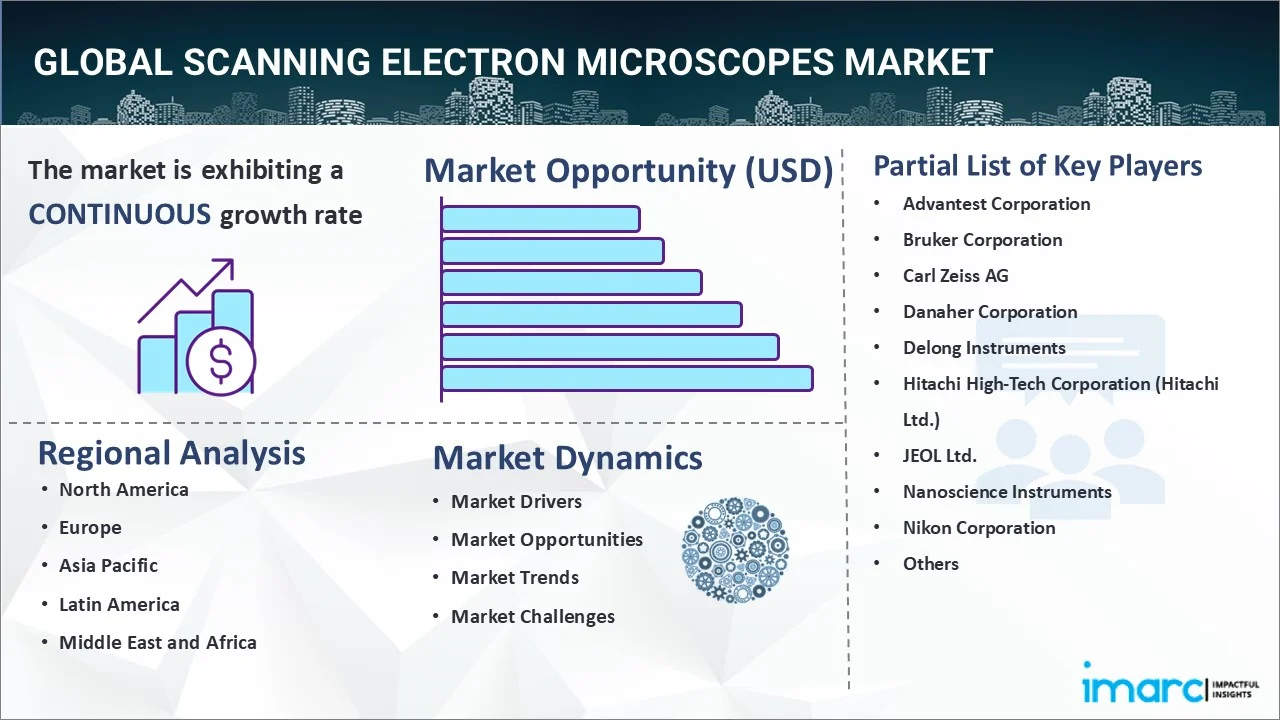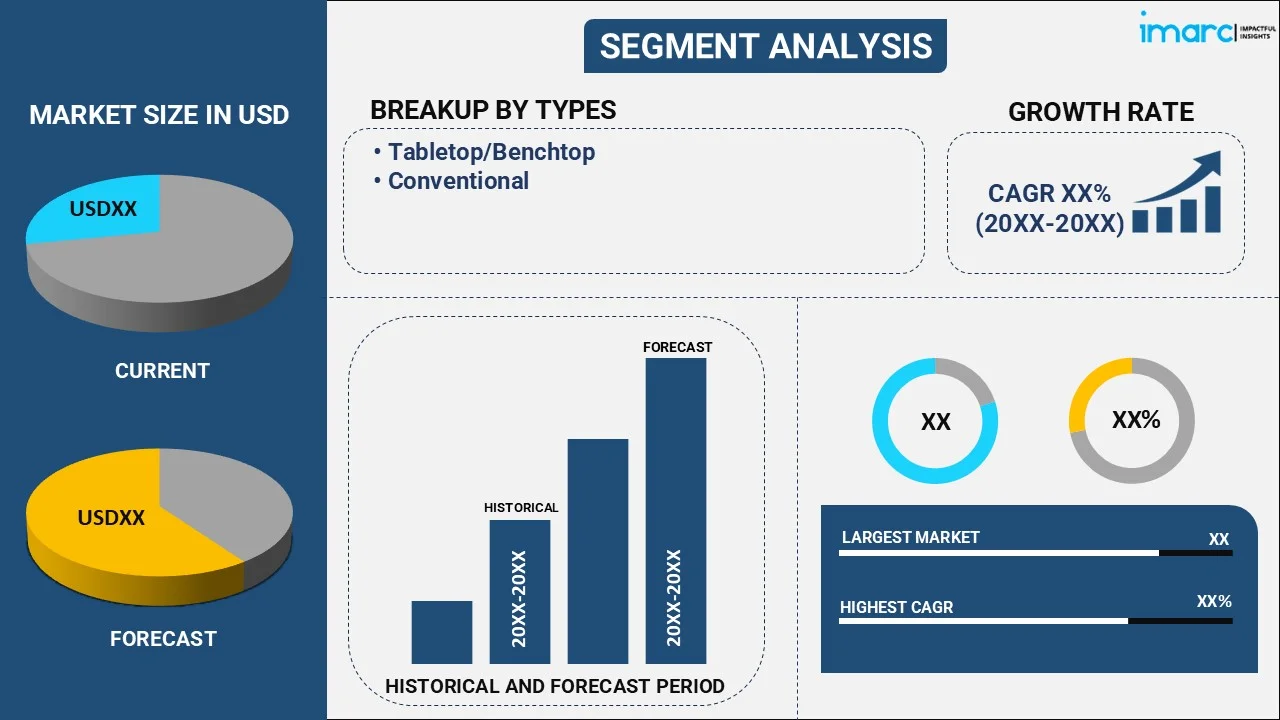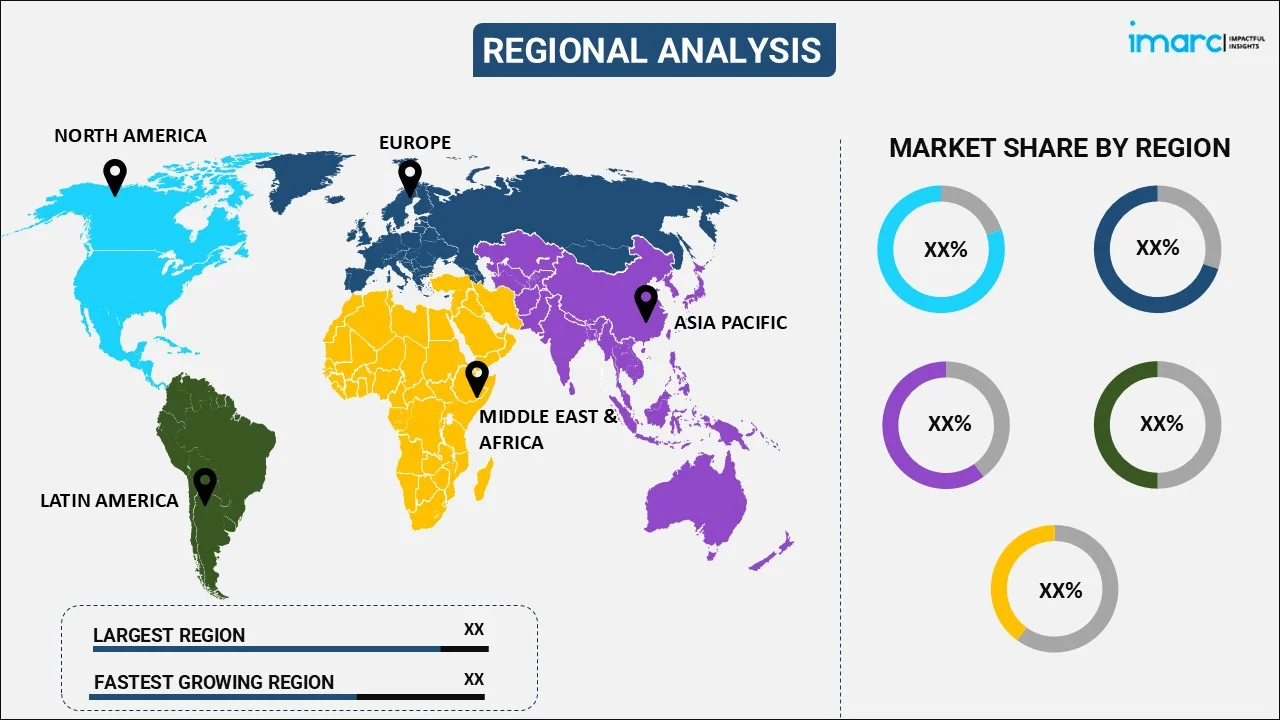
Scanning Electron Microscopes Market Report by Type (Tabletop/Benchtop, Conventional), Technology (Conventional or High Vacuum Scanning Electron Microscope (HVSEM), Variable Pressure or Low Vacuum Scanning Electron Microscope (LVSEM), Cryo-Scanning Electron Microscope (Cryo-SEM), Environmental Scanning Electron Microscope (ESEM), and Others), Application (Material Sciences, Nanotechnology, Life Sciences, Semiconductors, and Others), and Region 2025-2033
Scanning Electron Microscopes Market Size:
The global scanning electron microscopes market size reached USD 4.8 Billion in 2024. Looking forward, IMARC Group expects the market to reach USD 8.5 Billion by 2033, exhibiting a growth rate (CAGR) of 6.6% during 2025-2033. The market for scanning electron microscopes is being propelled by developments in nanotechnology, increasing number of laboratories in academic institutes, the growing prevalence of various chronic disorders, and a notable surge in biomedical research.
|
Report Attribute
|
Key Statistics
|
|---|---|
|
Base Year
|
2024
|
|
Forecast Years
|
2025-2033
|
|
Historical Years
|
2019-2024
|
|
Market Size in 2024
|
USD 4.8 Billion |
|
Market Forecast in 2033
|
USD 8.5 Billion |
| Market Growth Rate 2025-2033 | 6.6% |
Scanning Electron Microscopes Market Analysis:
- Major Market Drivers: The growing fields of material science and nanotechnology are driving the SEM market, as they require high-resolution imaging for studies at the nanoscale. The growing applications in biomedical research and the semiconductor industry's requirement for exact quality control as devices get smaller are further factors propelling the market expansion.
- Key Market Trends: The scanning electron microscopes market recent development highlights the noteworthy trend of combining SEMs with cutting-edge imaging methods, such energy-dispersive X-ray spectroscopy (EDX) for material characterisation, to improve their serviceability in a variety of industries while emerging advances in SEM operations include automation and digitalization, which increase user accessibility and efficiency.
- Geographical Trends: Superior production and outstanding research are two major drivers of the European market. North America and Asia-Pacific regions prosper in SEM segments through advanced research and development (R&D) activities, particularly for nanotechnology, semiconductors, and biotechnology sectors among others.
- Competitive Landscape: Some of the market’s key players include Advantest Corporation, Bruker Corporation, Carl Zeiss AG, Danaher Corporation, Delong Instruments, Hitachi High-Tech Corporation (Hitachi Ltd.), JEOL Ltd., Nanoscience Instruments, Nikon Corporation, Olympus Corporation, and Thermo Fisher Scientific Inc.
- Challenges and Opportunities: The growth of the SEM market is hampered by increasing costs of equipment and the need for intensive training. However, these problems also offer opportunities for market participants to come up with affordable ways of doing things and easier-to-use interfaces that are also good-looking. The demand for nanoscale materials in different industries continues to create new opportunities for applying SEM technology.

Scanning Electron Microscopes Market Trends:
Technological Advancements:
The powerful movement in nanotechnology and material sciences intrinsically generates the scanning electron microscopes market revenue. As analysts and engineers swoop into the nanometer scale to investigate, control, and make unused materials, gadgets, and frameworks, the requirement for high-resolution imaging propels the market growth. Furthermore, various progressions in SEM innovation, counting low-voltage electron microscopy for sensitive tests and in situ microscopy for energetic perceptions, guarantee maintained advertise development. Consequently, the scanning electron microscopes market growth is attributed to the expanding nanotechnology market which is expected to exhibit a growth rate (CAGR) of 28.83% over the forecast period spanning from 2024 to 2032 according to a report published by IMARC GROUP.
Growing Applications in Medicine:
Life sciences and medicine are finding increasingly new applications for scanning electron microscopes that are in demand of detailed cellular as well as molecular imaging. In fact, it gives the necessary knowledge about biological structures, which helps researchers to understand disease mechanisms, create pharmaceuticals as well as elucidate the microarchitecture of tissues. For example, the National Institutes of Health (NIH) in the United States, has close to $45 billion dedicated to medical research. This level of investment demonstrates their commitment toward improving healthcare services, extending human life, and minimizing sickness and disability. This is also creating a positive scanning electron microscopes market outlook.
Increasing Demand in Semiconductor Industry:
The semiconductor industry's continuous push for smaller, more efficient chips fuels the need for sophisticated imaging tools such as SEMs. SEMs are instrumental in the inspection and quality control of semiconductor wafers, allowing for the detection of surface defects and ensuring the reliability of microchips. It also allows for the detailed inspection of semiconductor wafers, detecting defects and verifying the manufacturing process's integrity by offering unparalleled resolution, thereby creating numerous scanning electron microscopes market opportunities. According to the IMARC GROUP, the semiconductor market revenue is anticipated to grow by USD 1,170.4 Billion by 2032.
Scanning Electron Microscopes Industry Segmentation:
IMARC Group provides an analysis of the key trends in each segment of the market, along with forecasts at the global, regional, and country levels for 2025-2033. Our report has categorized the market based on type, technology, and application.
Breakup by Type:

- Tabletop/Benchtop
- Conventional
Tabletop/benchtop accounts for the majority of the market share
The report has provided a detailed breakup and analysis of the market based on the type. This includes tabletop/benchtop, and conventional. According to the report, tabletop/benchtop represented the largest segment.
Tabletop/Benchtop SEMs are powerful tools for quality control, failure analysis, and materials characterization. It makes them a popular choice for quick and efficient analysis without the need for a dedicated operating space. Additionally, the growing market demand for tabletop/benchtops is driven by their size and ease of use which is contributing to their dominance in the market. Moreover, tabletop SEMs are ideal for educational purposes, quality control processes, and preliminary research, providing a balance between performance and convenience, thus influencing the scanning electron microscopes market demand.
Breakup by Technology:
- Conventional or High Vacuum Scanning Electron Microscope (HVSEM)
- Variable Pressure or Low Vacuum Scanning Electron Microscope (LVSEM)
- Cryo-Scanning Electron Microscope (Cryo-SEM)
- Environmental Scanning Electron Microscope (ESEM)
- Others
Conventional or high vacuum scanning electron microscope (HVSEM) holds the largest share in the industry
A detailed breakup and analysis of the market based on the technology have also been provided in the report. This includes conventional or high vacuum scanning electron microscope (HVSEM), variable pressure or low vacuum scanning electron microscope (LVSEM), cryo-scanning electron microscope (Cryo-SEM), environmental scanning electron microscope (ESEM), and others. According to the report, conventional or high vacuum scanning electron microscope (HVSEM)accounted for the largest market share.
The HVSEM market is dominating the market growth due to its wide application range, offering high-resolution imaging by operating in a high vacuum environment. It provides detailed and high-quality images, critical for advancing research and development in these fast-evolving fields resulting in significant growth in scanning electron microscopes market statistics. For instance, in July 2021, Thermo Fisher Scientific presented the thermo scientific phenom pharos G2 desktop field emission gun, a scanning electron microscope (FEG-SEM), that is a progressive instrument orginated to analyze numerous nanoparticles. It also enables precise identification of nanoparticles' dimensions, configurations, and chemical compositions with superior resolution.
Breakup by Application:
- Material Sciences
- Nanotechnology
- Life Sciences
- Semiconductors
- Others
Life sciences represents the leading market segment
The report has provided a detailed breakup and analysis of the market based on the application. This includes material sciences, nanotechnology, life sciences, semiconductors, and others. According to the report, life sciences represented the largest segment.
The life sciences represent the leading segment attributed to its applications in the field. Additionally, the increasing prevalence of chronic diseases is escalating the demand for advanced research and development (R&D) efforts, resulting in the adoption of SEMs due to their ability to provide detailed imaging of biological samples. Moreover, the widespread use of scanning electron microscopes to produce images of a sample by scanning it with a high-energy beam of electrons is contributing to the market growth. The SEM is significantly more powerful than a light microscope can produce images of up to 500,000 times greater magnification and can generate precise images of organisms as tiny as viruses and bacteriophages.
Breakup by Region:

- North America
- United States
- Canada
- Asia-Pacific
- China
- Japan
- India
- South Korea
- Australia
- Indonesia
- Others
- Europe
- Germany
- France
- United Kingdom
- Italy
- Spain
- Russia
- Others
- Latin America
- Brazil
- Mexico
- Others
- Middle East and Africa
Asia Pacific leads the market, accounting for the largest scanning electron microscopes market share
The market research report has also provided a comprehensive analysis of all the major regional markets, which include North America (the United States and Canada); Asia Pacific (China, Japan, India, South Korea, Australia, Indonesia, and others); Europe (Germany, France, the United Kingdom, Italy, Spain, Russia, and others); Latin America (Brazil, Mexico, and others); and the Middle East and Africa. According to the report, Asia Pacific accounted for the largest market share.
Asia Pacific dominates the global market due to its rapid growth in sectors such as semiconductors, automobiles, pharmaceuticals, and nanotechnology. Additionally, the presence of key manufacturers and rising demand for SEM for elemental analysis and imaging are contributing to the market growth. The market in Asia Pacific benefits from the technological advancements undertaken by various leading players in countries such as China and India. For example, in July 2023, JEOL Ltd. unveiled two innovative scanning electron microscopes. These latest SEMs are designed with advanced intelligent technology and automated features, simplifying the process for users to achieve rapid, high-definition imaging and analysis. The new models are engineered to effortlessly gather data across various specimen types.
Competitive Landscape:
- The market research report has also provided a comprehensive analysis of the competitive landscape in the market. Detailed profiles of all major companies have also been provided. Some of the major market players in the scanning electron microscopes industry include Advantest Corporation, Bruker Corporation, Carl Zeiss AG, Danaher Corporation, Delong Instruments, Hitachi High-Tech Corporation (Hitachi Ltd.), JEOL Ltd., Nanoscience Instruments, Nikon Corporation, Olympus Corporation, and Thermo Fisher Scientific Inc.
(Please note that this is only a partial list of the key players, and the complete list is provided in the report.)
- At present, key players in the) market are driven by advancements in technology and a growing focus on research and development. They are actively pursuing technological innovations, strategic partnerships, and expansions to enhance the global scanning electron microscopes market overview and respond to the increasing demand for sophisticated microscopy solutions across various sectors, including healthcare, semiconductor research, material sciences, and academics. For instance, in December 2021, Thermo Fisher Scientific Inc., a global leader in the science industry, announced the successful completion of its purchase of PPD, Inc., a foremost international provider of clinical research services to the biopharmaceutical and biotechnology sectors, for $17.4 billion.
Latest News:
- January 2024, Bruker disclosed its acquisition of Nion, a private entity known for its pioneering work in developing high-end scanning transmission electron microscopes (STEM). This strategic move broadens Bruker's range of products and enhances its technological assets in the field of materials science research.
Scanning Electron Microscopes Market Report Scope:
| Report Features | Details |
|---|---|
| Base Year of the Analysis | 2024 |
| Historical Period | 2019-2024 |
| Forecast Period | 2025-2033 |
| Units | Billion USD |
| Scope of the Report | Exploration of Historical Trends and Market Outlook, Industry Catalysts and Challenges, Segment-Wise Historical and Future Market Assessment:
|
| Types Covered | Tabletop/Benchtop, Conventional |
| Technologies Covered | Conventional or High Vacuum Scanning Electron Microscope (HVSEM), Variable Pressure or Low Vacuum Scanning Electron Microscope (LVSEM), Cryo-Scanning Electron Microscope (Cryo-SEM), Environmental Scanning Electron Microscope (ESEM), Others |
| Applications Covered | Material Sciences, Nanotechnology, Life Sciences, Semiconductors, Others |
| Regions Covered | Asia Pacific, Europe, North America, Latin America, Middle East and Africa |
| Countries Covered | United States, Canada, Germany, France, United Kingdom, Italy, Spain, Russia, China, Japan, India, South Korea, Australia, Indonesia, Brazil, Mexico |
| Companies Covered | Advantest Corporation, Bruker Corporation, Carl Zeiss AG, Danaher Corporation, Delong Instruments, Hitachi High-Tech Corporation (Hitachi Ltd.), JEOL Ltd., Nanoscience Instruments, Nikon Corporation, Olympus Corporation, Thermo Fisher Scientific Inc., etc. |
| Customization Scope | 10% Free Customization |
| Post-Sale Analyst Support | 10-12 Weeks |
| Delivery Format | PDF and Excel through Email (We can also provide the editable version of the report in PPT/Word format on special request) |
Key Benefits for Stakeholders:
- IMARC’s industry report offers a comprehensive quantitative analysis of various market segments, historical and current market trends, market forecasts, and dynamics of the scanning electron microscopes market from 2019-2033.
- The research report provides the latest information on the market drivers, challenges, and opportunities in the global scanning electron microscopes market.
- The study maps the leading, as well as the fastest-growing, regional markets. It further enables stakeholders to identify the key country-level markets within each region.
- Porter's five forces analysis assists stakeholders in assessing the impact of new entrants, competitive rivalry, supplier power, buyer power, and the threat of substitution. It helps stakeholders to analyze the level of competition within the scanning electron microscopes industry and its attractiveness.
- The competitive landscape allows stakeholders to understand their competitive environment and provides insight into the current positions of key players in the market.
Key Questions Answered in This Report
The global scanning electron microscopes market was valued at USD 4.8 Billion in 2024.
We expect the global scanning electron microscopes market to exhibit a CAGR of 6.6% during 2025-2033.
The growing prevalence of various chronic disorders, is leading towards the rising application of scanning electron microscopes in R&D activities for providing advanced healthcare solutions, which is primarily driving the global scanning electron microscopes market.
The sudden outbreak of the COVID-19 pandemic had led to the implementation of stringent lockdown regulations across several nations resulting in temporary closure of the numerous manufacturing units for scanning electron microscopes.
Based on the type, the global scanning electron microscopes market can be segmented into tabletop/benchtop and conventional. Currently, tabletop/benchtop holds the majority of the total market share.
Based on the technology, the global scanning electron microscopes market has been divided into Conventional or High Vacuum Scanning Electron Microscope (HVSEM), Variable Pressure or Low Vacuum Scanning Electron Microscope (LVSEM), Cryo-Scanning Electron Microscope (Cryo-SEM), Environmental Scanning Electron Microscope (ESEM), and others. Among these, Conventional or High Vacuum Scanning Electron Microscope (HVSEM) exhibits a clear dominance in the market.
Based on the application, the global scanning electron microscopes market can be categorized into material sciences, nanotechnology, life sciences, semiconductors, and others. Currently, life sciences account for the largest market share.
On a regional level, the market has been classified into North America, Asia-Pacific, Europe, Latin America, and Middle East and Africa, where Asia-Pacific currently dominates the global market.
Some of the major players in the global scanning electron microscopes market include Advantest Corporation, Bruker Corporation, Carl Zeiss AG, Danaher Corporation, Delong Instruments, Hitachi High-Tech Corporation (Hitachi Ltd.), JEOL Ltd., Nanoscience Instruments, Nikon Corporation, Olympus Corporation, and Thermo Fisher Scientific Inc.
Need more help?
- Speak to our experienced analysts for insights on the current market scenarios.
- Include additional segments and countries to customize the report as per your requirement.
- Gain an unparalleled competitive advantage in your domain by understanding how to utilize the report and positively impacting your operations and revenue.
- For further assistance, please connect with our analysts.
 Inquire Before Buying
Inquire Before Buying
 Speak to an Analyst
Speak to an Analyst
 Request Brochure
Request Brochure
 Request Customization
Request Customization




.webp)




.webp)












